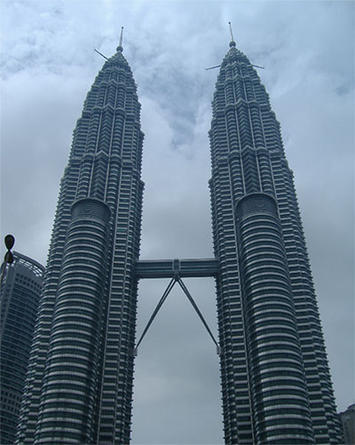
The Kuala Lumpur region of Malaysia is generally defined by the state of Selangor and two geographical enclaves (the federal territories of Kuala Lumpur and Putrajaya), carved from the state. These enclaves are the two seats of the federal government. Kuala Lumpur houses the national parliament and Putrajaya the executive and judicial branches.
Population Growth in the Kuala Lumpur Region
The Kuala Lumpur region had a population of approximately 7.1 million, according to the 2010 census. This includes 1.6 million in the federal territory (core city) of Kuala Lumpur and 5.5 million in the suburbs (which include Putrajaya). The region has experienced strong growth since modern Malaysia evolved between 1957 and 1963. In 1950, the region had only 900,000 residents. By 1980, the population had more than doubled to nearly 2.4 million and by 2010, the population had tripled from its 1980 level.
Unlike many urban cores, the city of Kuala Lumpur continues to experience strong population growth. Since 1980 (the first census after the creation of the new territory), the city has experienced a population increase of 77 percent.
Yet, the suburbs and exurbs (Note 1) have grown far more rapidly. The suburbs and exurbs have grown 280 percent and have added nearly six times the population increase of the city (Figure 1). This general distribution of growth continued over the past decade, with the suburbs attracting 83 percent of the new population, while the city of Kuala Lumpur received 17 percent of the growth (Figure 2).
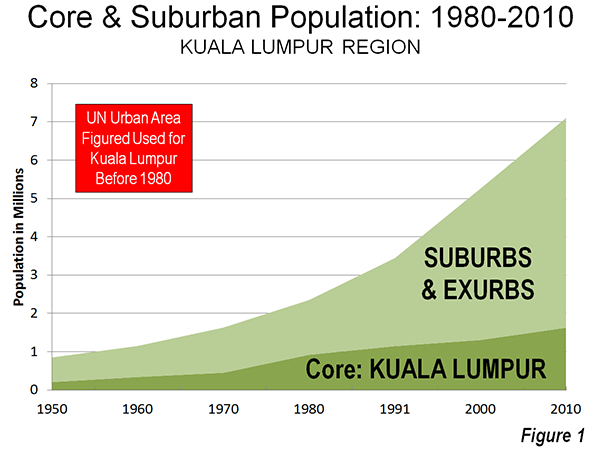
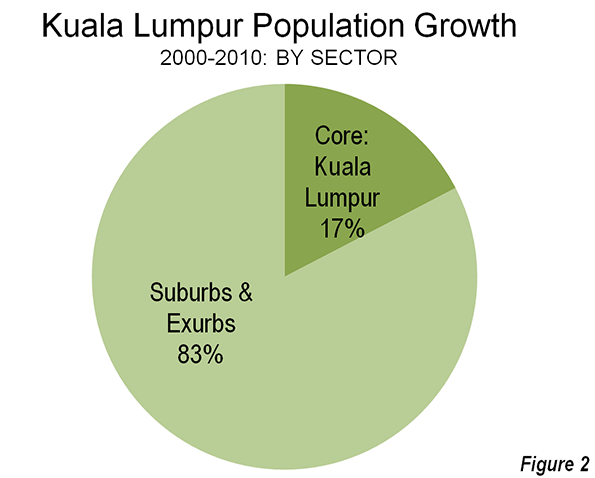
The region continues to grow faster than the nation and at the current growth rate, the Kuala Lumpur region could approach a population of 10 million by 2025.
The Urban Area
The Kuala Lumpur urban area (area of continuous urban development) has an estimated population of 6.6 million (2013). Kuala Lumpur ranks as the 49th largest urban area in the world (Note 2). The urban area covers an estimated 750 square miles (1,940 square kilometers), ranking it 42nd largest in the world. The population density is 8,800 per square mile (3,400 per square kilometer). Among the 70 world urban areas with more than 5,000,000 population, Kuala Lumpur ranks 56th in population density, with approximately the same density as Western European urban areas in the same size classification (Figure 3).

The highest population densities are in the city of Kuala Lumpur, at 17,300 per square mile (6,700 per square kilometer), approximately the density of the city of San Francisco. The suburban areas have a population density of 6,800 per square mile (2,600 per square kilometer), approximately five percent higher than the suburbs of Los Angeles (Figure 4).
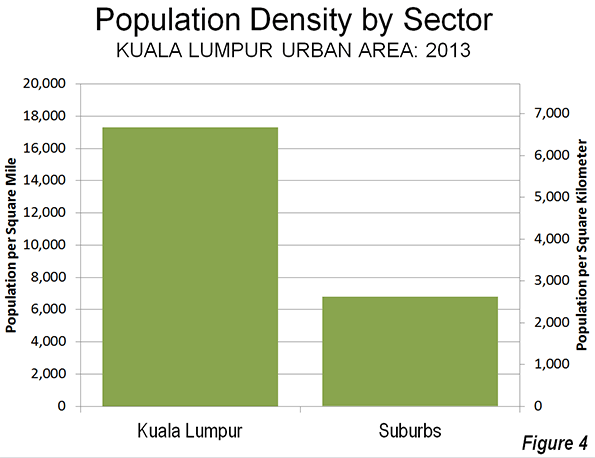
The Economy
Kuala Lumpur is a prosperous region by developing world standards. Only high-income Singapore is more prosperous in Southeast Asia. According to the most recent Brookings Global Metro Monitor, Kuala Lumpur has gross domestic product per capita of $23,900 annually (based on purchasing power). This is higher than all metropolitan economies in Latin America other than Brasilia, Monterrey and Buenos Aires. If Kuala Lumpur were in China, it would rank in the top quarter of the richest per capita metropolitan economies (Note 3).
The Setting
The urban area stretches from the core of Kuala Lumpur more than 20 miles (32 kilometers) westward to Port Klang on the Strait of Malacca, with similar expanses to the north and south. The urban area stretches less than 10 miles into the Titiwangsa Mountains, which forms the central cordillera of the Malay Peninsula.
Physical Description
The Kuala Lumpur urban area is located in a densely forested tropical region. The urban areas somewhat low density has permitted retention of substantial greenery. As a result, Kuala Lumpur appears to be among the "greenest" urban environments in East Asia, and for that matter, in the world. The greenery is especially evident in residential areas, where most housing is either detached or row house (Photos).
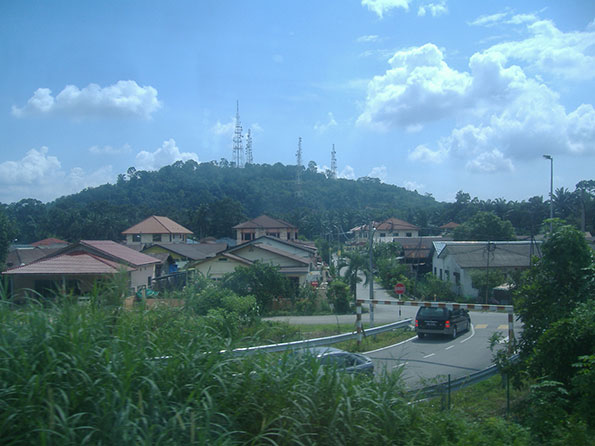
Detached housing
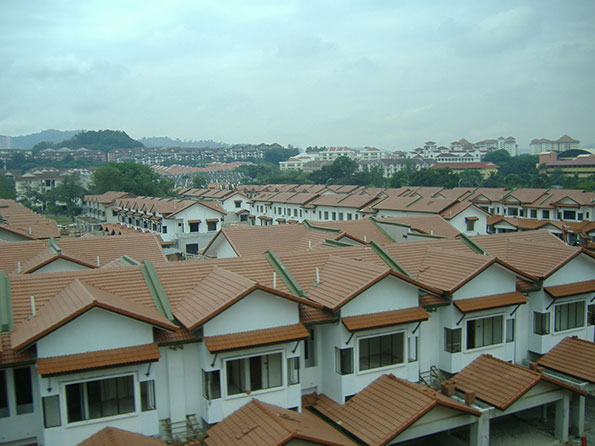
Row Houses
However, the greenery also extends to the central business district (Photo: Kuala Lumpur's Green Central Business District), where the largest buildings are much less densely packed than in most large world cities. Kuala Lumpur's central business district is home to the Petronas Towers (Photograph above), twin towers that became the tallest buildings in the world upon completion in 1998, displacing Chicago's Sear's Tower (now Willis Tower). The title was lost to Taipei's Tower 101 in 2004.
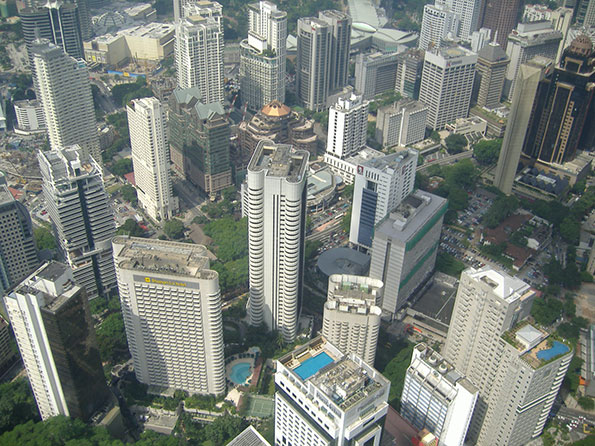
Photo: Kuala Lumpur's Green Central Business District
Kuala Lumpur is not monocentric. The central business district accounts for only 12 percent of regional employment, a figure that is projected to decline (Figure 5). The central business district share is slightly more than the United States average (10 percent) and less than the Western European average (18 percent).
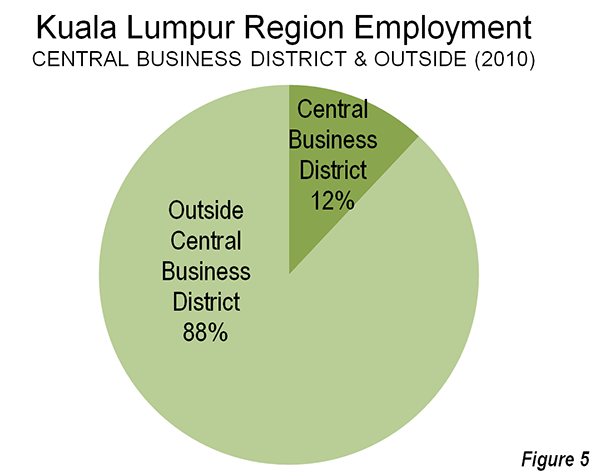
Transport
The Kuala Lumpur region principally relies on personal mobility (cars and motorcycles) for its transportation. As late as 1985, 35 percent of travel in the Kuala Lumpur was by mass transit. By 2010, this had fallen to between 10 and 12 percent. This is after opening three metro lines, a monorail and three commuter rail lines, with the metro and monorail lines having opened since 1995. Kuala Lumpur's mass transit market share is more reflective of a high-income nation region than a middle income nation, comparable to Sydney, Toronto or New York and one-third below that of Western Europe. However, Kuala Lumpur is much more transit dependent than most US metropolitan areas, at five to 10 times that of Los Angeles, Portland, Seattle, Dallas-Fort Worth and Phoenix.
The Kuala Lumpur region is served by an extensive network of expressways. One segment includes the "SMART" tunnel, which is a 6 mile (10 kilometer) long tunnel that serves both vehicles and storm water. While the tunnel has levels dedicated to both vehicles and storm water, the entire tunnel can be converted to storm water usage when there is serious flooding.
Prospects
Kuala Lumpur seems well positioned for the future. As the urban area has expanded in population and land area, its populace has achieved a level of affluence toward which much of the world strives.
Wendell Cox is a Visiting Professor, Conservatoire National des Arts et Metiers, Paris and the author of “War on the Dream: How Anti-Sprawl Policy Threatens the Quality of Life.”
------------------
Note 1: See "Definition of Terms used in The Evolving Urban Form"
Note 2: The comprehensive Demographia World Urban Areas is published at least annually, with the next (9th) annual edition due in the Spring of 2013.
Note 3: The ranking for Chinese metropolitan areas is adjusted, using the population figures from the 2010 census (which included the urban migrant population). The issue is described in Endnote 19 in the Brookings Global Metro Monitor.
-------------------
Photograph: Petronas Towers (all photos by author)













Great stuff from you. I love
Great stuff from you. I love what you've got here, love what you're saying and the way you say it. You make it entertaining. I cant wait to read more from you. This is really a great article.
get soundcloud downloads
You definitely know what you
You definitely know what you were talking about and seem to have a very high interest on the topic. I like visiting your blog and honestly I love the information you provide here, Your intelligence on the post could be giving us new knowledge
http://carbulosservaringen.moc2008.com
Hi, I do think this is a
Hi, I do think this is a great site.
I stumbledupon it I’m going to come back yet again since I book marked it. Money and freedom is the best way to change, may you be rich and continue to help other people.
clash of clans gems hack
Feel really happy to have
Feel really happy to have seen webpage where still among the leading topics of our time. You're very smart writer and look forward for more entertaining times reading here
http://handyortungkostenlosblog.com
Sometimes it is so hard to
Sometimes it is so hard to find good and useful posts out there when doing research. Now I will send it to my colleagues as well. Thank you for being one of them. Thanks for sharing your knowledge on this particular aspect and making it easier for us.
Swoggi Scam
This is such a great
This is such a great resource that you are providing and you give it away for free. I love seeing blog that understand the value of providing a quality resource for free. I am grateful to you for sharing this info with me. thanks much..Handy orten tips
Online reading is not my
Online reading is not my thing. But after reading your blog I am really pleased. I don’t know about other blogskamagra oral jelly
Wonderful Info
Wonderful and very EXCELLENT post.. You have a natural way of writing yet seem to have so much passion about this issue. i always feel obligated to read article from this page.. they are simply AWESOME and this post is MIND BLOWING with Fascinating information... Here is the USEFUL REFERENCE which explains better.
If you want a cookie-cutter
If you want a cookie-cutter house located outside the city in cookie cutter suburban shopping mall hell with a snarled morning commute- then sure- you can scoop up such a gem for 150k-200k.
mba personal statements
Weighty and SUCCINCT
There are so many different prospects when it comes to this subject. Thanks for sharing your knowledge on this particular aspect and making it easier for us.This post has helped me to have another perspective.FIND MORE INFO right here.